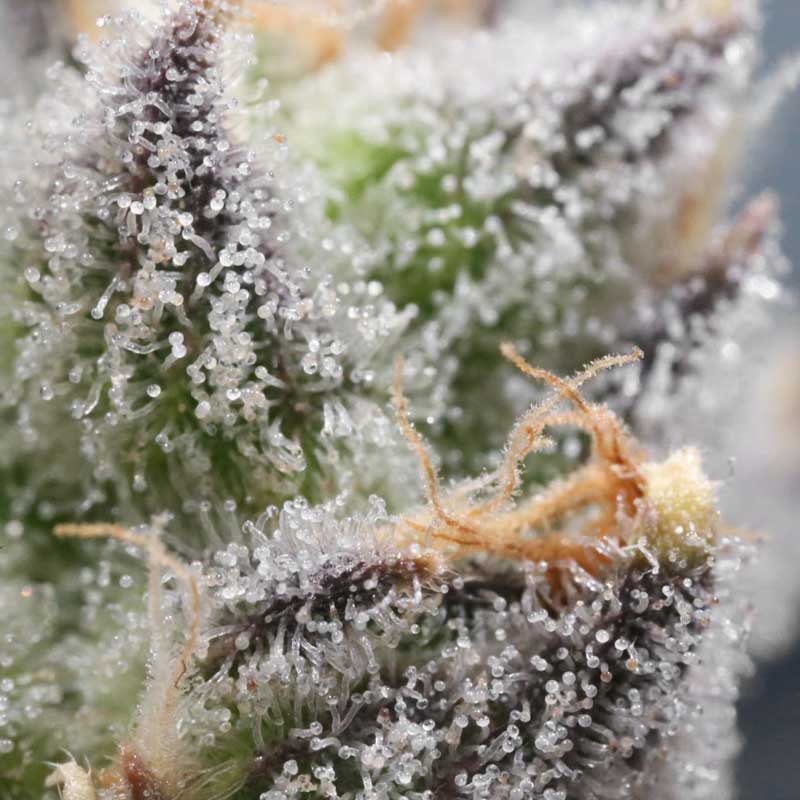What are Trichomes?
Trichomes are tiny outgrowths on the surface of plants. They are found in various shapes and sizes, from tiny hairs to larger glandular structures. Trichomes serve multiple functions for the plant, including protection from predators or environmental stressors such as UV radiation or extreme temperatures.
They are small appendages that grow outwards from the epidermis layer of a plant’s leaves and stem. These projections vary in size and shape depending on their function; some may be short and hair-like, while others may be longer and more bulbous in appearance.
The primary purpose of a trichome is to protect plants against physical damage caused by insects, animals, weather conditions (such as strong winds), or other environmental factors like excessive heat or coldness. They also help reduce water loss through transpiration by providing an additional barrier between the environment and the leaf surface. Finally, trichomes are essential in regulating specific chemical processes within a plant’s cells, which can affect its growth rate or flowering period, among other things.
Chemistry
Trichomes are composed mainly of lipids (fats) with some proteins mixed in for structural support; these molecules interact to form cutin, a waxy substance that helps keep moisture inside cells while preventing it from evaporating into the atmosphere outside them. This process helps regulate plants’ temperature levels, which is essential for proper growth development over time.
Trichomes are essential to the plant’s defense and production system, and understanding their function is vital to effective harvesting techniques. Next, we’ll examine how somebody can harvest trichomes for maximum cannabinoid and resin production.
Harvesting Trichomes
Harvesting trichomes is the process of collecting and extracting the resin-producing glands found on the cannabis plant or other plants. Trichomes in cannabis are small, mushroom-shaped structures that contain cannabinoids and terpenes, which give it its unique flavor and aroma. Depending on the desired outcome, the harvesting process can be done manually or automatically.
Ripe vs. Unripe Trichomes
The ripeness of trichomes determines their potency, so it’s essential to know when they are ready for harvest. Unripe trichomes appear clear and glassy, while ripe ones look cloudy or milky in color. Harvesting the trichomes too early will result in less CBD and THC content in the case of cannabis. On the other hand, harvesting too late will reduce cannabinoid production as well as degrade terpene quality due to oxidation from UV exposure.
Cannabis Trichomes
Cannabis trichome production varies between strains, but most varieties produce enough resin to make them worth harvesting. In addition to providing flavor and aroma, these tiny glands also act as a defense mechanism against pests by producing bitter-tasting compounds that ward off predators such as insects or animals looking for an easy meal.

Processing Trichomes
Trichomes are small outgrowths of plant cells that have a variety of functions. For example, they can provide protection from predators, store nutrients, and even produce essential oils or resins. As a result, processing trichomes is an important part of many industries, including food production and herbal medicine.
Color and Texture of Trichomes
Trichomes come in a wide range of colors, textures, shapes, sizes, and densities depending on the species they’re found on. Some trichome types are short hairs, while others may be long filaments or bulbous glands with sticky secretions at their tips. Colors range from white to yellow to green to purple-black depending on the type and age of the trichome and its location within the plant tissue. In addition, the texture varies significantly between different types; some are waxy, while others feel more like velvet or sandpaper.
Several methods for extracting trichomes from plants depend primarily on what type is being processed. In addition, what end product is desired by the user/manufacturer (e.g., oil extraction vs. powder)? Standard extraction techniques include mechanical separation using sieves or other filtering devices; solvent extraction using alcohols such as ethanol; steam distillation; cold pressing; supercritical fluid extraction (SFE); sublimation; hydrolysis; enzymatic digestion; freeze-drying/lyophilization. Each method has its own advantages and disadvantages, so it is important to research thoroughly before deciding which one best suits your needs.
Science Behind Processing
The science behind processing trichomes involves understanding how they interact with their environment, including temperature, light intensity, humidity levels, air pressure, etc. It also requires knowledge of chemical properties like solubility in different solvents or oils and physical characteristics such as size distribution and surface area-to-volume ratio that can affect the diffusion rate during extraction. By studying these factors carefully, manufacturers can ensure their products meet quality standards while preserving the active ingredients within trichome structures.
Supercritical fluid extraction (SFE) utilizes pressurized carbon dioxide gas at high temperatures to extract compounds from the plant material without damaging them. This makes it ideal for producing highly concentrated extracts that retain all their natural flavors and aromas without the need for additional additives. In addition, we can improve upon existing recipes or create new ones by understanding how each processing technique works.
Processing trichomes is essential to utilizing their properties, and understanding the science behind this process can benefit entrepreneurs greatly. Next, we will discuss some common uses for trichomes in various industries.
Uses of Trichomes
They have a variety of functions, including protection from predators and environmental stressors. Trichomes also contain many beneficial compounds that can be used for medicinal, industrial, and culinary purposes.
Culinary Uses:
Cannabis trichomes are becoming increasingly popular among chefs who want to infuse their dishes with unique flavors without adding psychoactive effects associated with marijuana consumption. Chefs have been experimenting with adding cannabis trimmings directly into soups or salads. Still, there are now companies producing concentrates explicitly made for cooking applications that allow users greater control over dosage size while still providing all the flavor profiles associated with various strains of cannabis without any psychoactive effects whatsoever.
Trichomes have a wide range of medicinal, industrial, and culinary uses. Therefore, understanding the safety considerations for working with trichomes is important to ensure safe and successful processing.
Medicinal Uses:
Trichomes from cannabis are rich in cannabinoids such as THC and CBD, which have been studied extensively for their potential therapeutic benefits. These compounds interact with our endocannabinoid system to provide relief from pain, inflammation, anxiety, depression, nausea, and more. In addition to these cannabinoids, trichomes also contain terpenes which give cannabis its unique aroma and flavor profile but may also offer additional therapeutic benefits when combined with cannabinoids.
Industrial Uses:
Trichome resin is often extracted using solvents or mechanical processes like dry sieving or ice water extraction for use in various products ranging from textiles to cosmetics to building materials due to its waterproofing properties. In addition, the oils produced by trichome glands can be used as lubricants or fuel additives, while the waxes they produce can be used as emulsifiers or thickeners in food products like cheese spreads or salad dressings.

Cannabinoids and Resin Production
Trichome resin contains both cannabinoids (THC/CBD) and terpenes which provide medicinal benefits when consumed orally or inhaled through smoking/vaping methods. Cannabinoid levels vary greatly depending on strain genetics; some strains may have higher concentrations of THC than others, while others may have more CBD. It is, therefore, important to research different varieties before choosing one for cultivation purposes. Additionally, certain environmental factors, such as light exposure, can affect cannabinoid levels during flowering stages, so growers must pay close attention throughout the entire growth cycle to achieve optimal results. With careful consideration of harvesting ripe vs. unripe trichomes and understanding how cannabinoids and resin production are affected by cannabis trichomes, we can now explore the science behind processing these delicate structures.
Considerations when Working with Trichomes
When working with trichomes, it is important to wear protective gear such as gloves, masks, and goggles to protect against contact with any allergens or irritants that may be present in the plant material. It is also important to ensure all equipment used for harvesting or processing is properly sanitized before use so the product is not contaminated.
Proper Storage and Handling:
Once harvested, trichomes should be stored in a cool, dry place away from direct sunlight or heat sources until they can be processed further. Proper handling techniques should also be employed when transferring them from one container to another to prevent contamination during transport. Additionally, avoiding touching the trichome material directly with your hands is important since this could introduce bacteria into the product, leading to spoilage if not handled correctly.
Trichomes can be divided into three types: glandular trichomes, non-glandular trichomes, and emergencies. Glandular trichomes produce secretions such as oils, resins, and waxes that provide protection from herbivores or act as a barrier against environmental stressors. Non-glandular trichomes are typically unicellular hairs that help protect the plant from physical damage and desiccation. Finally, emergencies are protrusions with multiple cells that aid in water absorption and gas exchange between the plant’s environment and internal tissues. All three types of trichomes have important roles.
How do trichomes affect plant growth and development?
Trichomes are specialized cells that grow on the surface of plants and play an important role in plant growth and development. They protect from extreme temperatures, UV radiation, pests, and pathogens. Trichomes also produce essential oils that act as natural insect repellents or attractants for pollinators. Additionally, trichomes can help regulate water loss by providing a barrier to evaporation. This helps maintain optimal moisture levels for healthy growth and development of the plant. In short, trichomes are essential to a healthy plant life cycle as they protect against environmental stressors while aiding in efficient nutrient uptake and reproduction.
How do trichomes defend against herbivores?
To defend against herbivores, trichomes produce a variety of compounds that act as deterrents, such as terpenes, phenolics, and alkaloids. These compounds may taste bad or even be toxic to certain animals, making them less likely to feed on the plant material. Additionally, trichomes create physical barriers by forming an impenetrable layer over the leaf surface, preventing herbivores from accessing nutrient-rich tissue. Trichomes are a crucial part of plant defense, helping to ensure survival in their natural environment.
How can trichome production be increased in plants?
One of the most effective ways is to optimize environmental conditions, such as temperature and humidity, for the plant’s growth. Providing adequate nutrition and light exposure will also help increase trichome production. Finally, using certain hormones or compounds that stimulate trichome formation may also be beneficial. All these strategies should be implemented together to maximize trichome production in plants.
What are some methods for harvesting and processing trichomes from plants?
Harvesting trichomes from plants can be done in a few different ways. One method is to use an electric trimmer to remove the glandular hairs without damaging the plant material. Another option is to use a dry sieve or tumbler, which works by gently shaking and agitating the plant material until the trichomes are separated. Finally, one could also employ manual trimming techniques with scissors or tweezers for more precise harvesting of specific parts of the plant. Processing these harvested trichomes involves extracting them from their source material using solvents such as ethanol or CO2, then purifying and concentrating them into desired products like oils and waxes.
Conclusion
Trichomes are essential to the cannabis plant and can be used for various purposes. From harvesting to processing, trichomes can provide us with valuable cannabinoids and resin. Therefore, it’s important to understand the chemistry behind trichomes and how to harvest and process them to maximize their potential safely. With proper knowledge and care, entrepreneurs can use this powerful botanical resource to create products that benefit themselves and their customers. Trichomes have much more potential than most people realize, so entrepreneurs must take advantage of this unique opportunity by exploring all the possibilities they offer.
Do you want to learn more about trichomes and botanical processing? Join us at extraktLAB! We are developing innovative solutions for extracting, analyzing, and producing plant-based materials. Our cutting-edge technology allows us to maximize efficiency while maintaining quality control standards. Explore our capabilities in creating natural products that can revolutionize industries across the globe. Let’s work together towards a greener future with extraktLAB!




